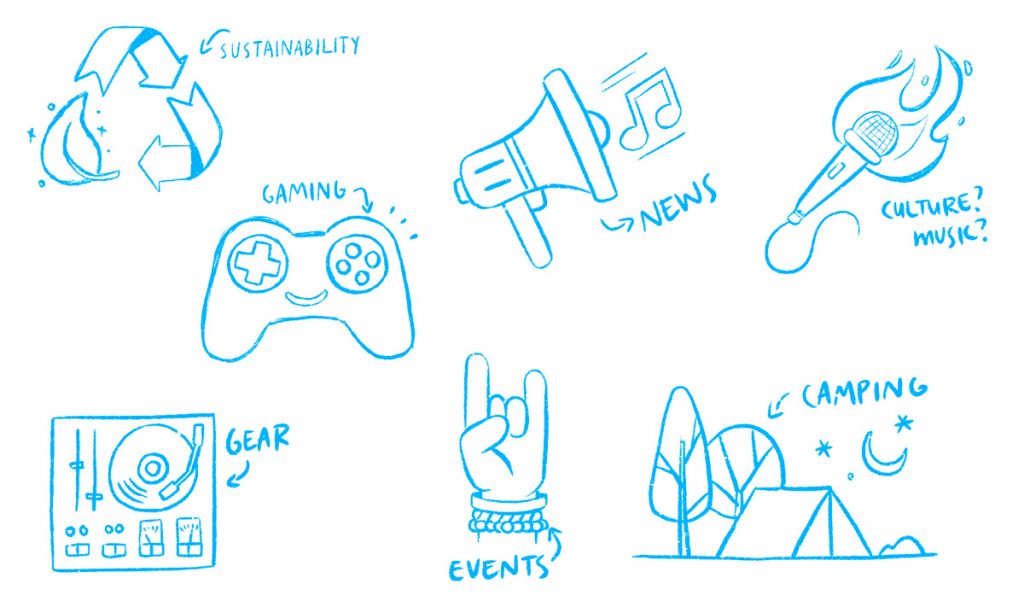Step 1 – Know and understand the client
Write a short, informal paragraph to describe the type of graphic designer you want to be. It can have as many words as you feel fit and can be in any format you wish: draw a picture, add a photo, or make a mind map. Let your personality shape the delivery.
The questions below may kickstart the process:
- What kind of job do you want to wake up to every day? What do you want to do daily?
- Which type of clients do you want to work with?
- After pinning down your interests and vision of yourself as a professional, in which areas do you think you need more growth and experience?
- What are your next steps to fulfil who you want to be as a graphic designer?
If you are unsure, think of the different courses you’ve done so far in your studies and the projects you enjoyed most – where did you naturally flourish, and which projects did you unexpectedly shine in?
ANSWER:
I want to be a graphic designer working on Publication, Marketing & advertising graphic design. A dream would be to be able to do design work for a Festival. Clothing design has also been a thing that has cought my attention in the past years, designing peaces for artists to wear. The music industry is where I probably would want to end up designing in, combining these types of design in the same environment. I think I need more experience in branding, marketing and promotional design, but also fashion design and typography. I really do love the idea of including animation, and even 3D animation in some type of projects when it comes to this industry. The next steps for me should be to deep diver into the themes and practise these skills further to be able to make a good resume and portfolio of work that I will do on my free-time or freelance.
Step 2 – Gather critical information and discover more
Start with the brief. If you feel the brief lacks information, follow it up as quickly as possible with the client. After reading the brief, answer some of the following questions in your own words to really internalise what you need to deliver:
- What is the design product that needs to be delivered? (Examples: logo, website, layout, advert, or packaging design.)
- Where is this design product going to be used? In what setting?
- By whom? Who is this design product for? (Target market).
- In what style does the design product need to be?
- Does the client have a current brand? Do you need to follow style guidelines?
- If you don’t have to follow any existing style guidelines, do you need additional guidance from them regarding the style, or can you use your own creative freedom?
By answering these questions in your own words, you are re-writing the brief to some extent and transforming it into a creative brief. This new, enhanced version of the brief should give you the following:
- unexpected information;
- that will lead to new insights;
- to creatively solve the problem;
- from the end-user’s point of view (the consumer).
You can never collect too much information. But you can, however, have a scarcity of information. And if you’re working with scraps of information and your own assumptions, it will lead to shallow solutions (or no solutions at all). The key is to ask meaningful questions – in the industry; these will be directed to the relevant role-players.
As a student doing a course assignment, you can still ask these meaningful questions and post them on the Discussion Forum or try and answer them yourself by doing research online. The bottom line is you need to think on a deeper level beyond the brief. Gathering and analysing information this way will lead to discovering unique and intriguing ideas that will fuel your design solution.
Do you see how design is not really subjective after all? It’s informed and is the result of careful study and consideration. It’s not about the personal opinions and whims of the designer or the client. Working in the industry, you’ll have to carefully navigate through people’s personal views and feelings about aesthetics. The graphic designer’s job is to keep the project on track and stay true to the facts, findings and observations.
Sometimes you’ll be in the difficult position of convincing the client of the decision for your design. You must then be able to defend it with critical information about the project. There will be times, however, when you’ll simply have to bend to the client’s will, which will be hard. But at least don’t go down without a fight.
Step 3 – Follow a creative strategy
In today’s lesson, we talked about the quiet before the storm in a project – where you have all the information you need, and you now have to think of ideas to communicate them visually. This is a delicate and precious stage in the creative process and will determine the way forward.
Keep Paula Scher’s talk in mind when thinking of ideas:
- Embrace play and the unexpected.
- Don’t repeat the same recipe for success.
- Don’t be afraid of taking on something a little beyond your abilities.
- Don’t be scared of being a fool.
- Experiment!
Today you don’t need to do anything for this lesson task. Just think and wonder about it all and try not to be too solemn; instead, embrace play (whatever that means to you specifically).

ANSWER:

Step 4 – Present and deliver
Thinking back on the course assignments you’ve completed in your studies, how has your journey been regarding feedback on your work from the outside world? When showing your design to someone and they give their opinion and suggestions:
- Do you feel they are undermining your artistic abilities?
- Do you try to see reason in the feedback and see how you can interpret it your way?
- Do you feel overwhelmed and lost and unsure which direction you should go in?
These feelings are valid and experienced by most graphic designers – even seasoned ones working in the industry for years. You have to learn to cope with feedback in a way that will contribute to your growth as a graphic designer but also keep your unique voice as an artist.
Write a short paragraph on your experience with feedback and how you’ve uncovered parts of yourself you did not even know existed. Do you think you have grown? Are you ready for the outside world and its opinions, and do you feel you have enough confidence to stand your ground if needed?
ANSWER:
When getting feedback I usually take it as a learning situation. Most of the time I agree with the feedback, and if I don’t i’ll try to curve it more in my own direction, but usually do a change to the design with reference from the feedback. Sometimes I feel unsure about the direction, and that’s when feedback from for example friends are great. If I do like a design choise I’ve done though, I will stand my ground. An exampe is a recent hobby poster I did with the inspiration from a friend that likes Formula 1, and specifically the McLauren 1998 MP4/4. He really wanted me to include a picture of Ayrton Senna, but after doing a lot of layout tests and experiments of design I did not feel it fit anywhere. He tried his best to make me include it, but for my opinions sake of what was best for the design, I could not let that go.
MA01
Adobe InDesign is the main programme you’ll use when working with layout design. You may be more comfortable doing layouts in Illustrator, for example. Still, InDesign is the best option when working with multi-page documents, lots of text, and different kinds of image material.
There are three course options to choose from below. Read through each description and decide which option will suit you best. Either way, you’ll benefit immensely from completing any of these three courses.
You only need to choose one of the courses below. After completing one of these, you will:
- be able to implement all you’ve learnt in your course assignment (which will be a significant addition to your portfolio).
- receive a LinkedIn Learning® Certificate you can add to your resume.
- have better knowledge of Adobe InDesign and will be more prepared to enter the work industry.
Hand in the LinkedIn course certificate as part of your course assignment report.
ANSWER: